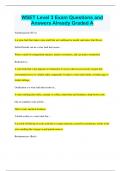WSET Level 3 Exam Questions and Answers Already Graded A Trichloranisole (TCA) Is a wine fault that makes wine smell like wet cardboard or mould, and mutes fruit flavors Sulfur Dioxide can be a wine fault that causes... Wine to smell of extinguished matches, masks its fruitiness, and can lead to oxidization Reduction is... A wine fau lt that is the opposite of oxidization. It occurs when an excessively oxygen -free environment leaves to volatile sulfur compounds. It makes a wine smell stinky, of rotten eggs or boiled cabbage. Oxidization is a wine fault that results in... A wine smellin g like toffee, caramel, or coffee; muted fruit and freshness; deep brown color. Out of condition wine will be... Dull or stale, and lack freshness Volatile acidity is a wine fault that ... Is a result of build up of acetic acid due to oxygen exposure; caus ed by acetobacter; results in the wine smelling like vinegar or nail polish remover Brettanomyces (Brett) The most likely cause of a wine that has an unpleasant aroma of Band -Aids, as well as a "sweaty" or "horsy" odor; caused by wild yeasts that are often present in rustic styles of winemaking Primary aromas and flavors Fruit (Green, Citrus, Stone, Tropical, Red, Black, Purple, Dry, Cooked), Floral, Herbal, Herbaceous, Spice, Stone/Other. Resulting from grapes and alcoholic fermentation. Secondary aromas a nd flavors Yeast, MLF, Oak. Result of winemaking techniques (post -fermentation) Tertiary aromas and flavors Deliberate oxidization, Fruit development, Bottle age. Resulting from maturation of wine. Sweetness in food increases/decreases what in wine? Increa ses: bitterness, acidity, alcohol burn Decreases: body, sweetness, fruitiness *Considered a high risk food - makes wine last harsh and astringent Umami in food increases/decreases what in wine? Increases: bitterness, acidity, alcohol burn Decreases: body, sweetness, fruitiness *Considered a high risk food - makes wine last harsh and astringent Acidity in food increases/decreases what in wine? Increases: Body, sweetness, fruitiness Decreases; Acidity What is the rule when pairing acidic foods with wine? The wine should have at least as much acidity as the food. High levels of acidity in food can make a low acid wine seem flabby/flat. Salt in food increases/decreases what in wine? Increases: Body Decreases: Bitterness, Acidity Bitterness flavors in wine an d food are... Cumulative Chili heat in food increases/decreases what in wine? Increases: Bitterness, acidity, alcohol burn Decreases: Body, richness, sweetness, fruitiness Sweet food should be paired with a wine that... has at least as much sugar as the fo od Umami foods should be paired with wine that... is more fruity than tannic Bitter foods should be paired with what kind of wines? White wines or low tannin reds Foods with chili heat should be paired with what kind of wine? White wine or low tannin reds, preferable with lower alcohol levels A higher risk wine when it comes to food pairings would have what structure characteristics? High levels of tannin, acid, alcohol, and complexity A very low risk wine when it comes to food pairings would have what structure characteristics? Simplicity, unoaked, a little residual sugar Name two sweet wines and the temperature at which they should be served Sauternes, Muscat Well -Chilled: 6 -8 C / 43 -45 F Name two sparking wines and the temper ature at which they should be served Champagne, Cava Well -Chilled: 6 -10 C / 43 -50 F Name two light/medium white wines and the temperature at which they should be served Pinot grigio, Sauvignon blanc, Fino sherry Chilled: 7 -10 C / 45 -50 F Name two examples of medium to full bodied oaked white wines and the temperature at which they should be served White burgundy, Fumé Blanc Lightly Chilled: 10 -13 C / 50 -55 F




